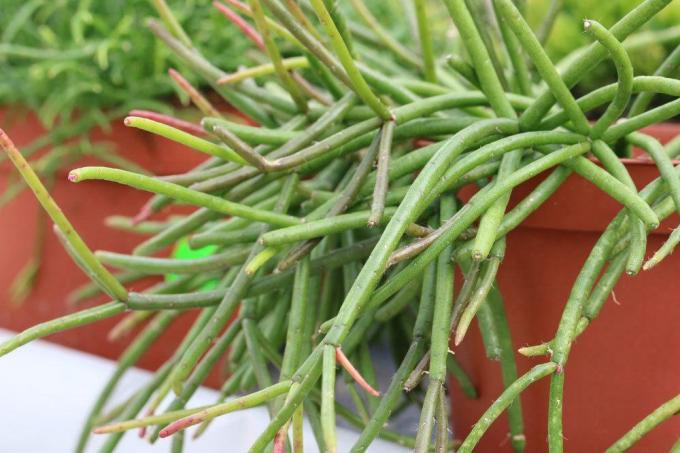
table of contents
- Toxins
- Risks to cats
- Risks to Children
The so-called Coral cactus (or "Rush Cactus") of the genus Rhipsalis is more exotic for many fans Indoor plants raise the question of whether they are poisonous and therefore potentially dangerous plant species acts. This question is entirely justified and should always be particularly urgent when it comes to indoor plants be discussed if the respective premises are also inhabited by children and one or two house cats will.
Toxins
Does the coral cactus contain toxins?
The coral cacti are not necessarily suitable for consumption in any way, but they do not contain any toxins worth mentioning. Botanists consider the plant to be “probably harmless”: This means that the relatively few Investigations that have so far been carried out on this plant species have not provided any evidence of any toxic substances were found. The coral cactus is officially not considered poisonous, but it should still be treated with healthy respect and under no circumstances be used for consumption. This applies to the following, particularly popular subspecies, among others:
- Rhips. cassutha
- Rhips. cereuscula
- Rhips. baccifera
- Rhips. crispata
- Rhips. houlletiana
The reputation of the Rhipsalis cacti as poisonous houseplants
In the past, warnings were given in some places against this type of plant and pointed out to the possible toxicity of the elongated shoots. As already mentioned, there is no evidence for toxic ingredients. However, it is reasonable to assume that the danger of the Rhipsalis cacti is based on their visual similarity to the euphorbias. After all, there are some species of the so-called milkweed family, which look relatively similar to the coral cacti and which are actually poisonous to a serious extent.

Play it safe with the coral cactus
When purchasing houseplants from specialist retailers, you can generally assume that you will receive a correctly identified and labeled plant. Whether the purchased specimen is actually a representative of the coral cacti and not a milkweed plant can be determined quickly and easily check: As the name suggests, instead of being cut or broken off plant parts, milkweed plants immediately give a milky sap away. In the case of the coral cacti, on the other hand, the sap is clear. It is therefore sufficient if a cut is made in one part of the plant with rubber gloves and a sharp knife. If only transparent sap then emerges, it is not a poisonous milkweed plant, but actually a relatively harmless coral cactus.
Risks to cats
The keeping of cats in an apartment with Rhipsalis cacti
Especially when cats are kept as indoor cats, they often attack all indoor plants on the windowsill. If a cat gnaws at the coral cacti in the apartment from time to time, it usually does not harm the animals. Of course, tastier alternatives such as cat grass cultivated especially for this purpose can also be offered The house tiger, with its cravings for green food components, does not necessarily have to rush to the coral cacti.

Risks to Children
Precautions for children in the home
Even if the coral cacti generally pose no danger to children: As soon as children are regularly unsupervised in If you are in a room, plants that are absolutely safe for the children should be placed there at a height that is accessible to the children be. According to the current state of knowledge, this also applies to coral cacti - but it cannot either harm to make such a plant inaccessible to younger family members in case of doubt place.
